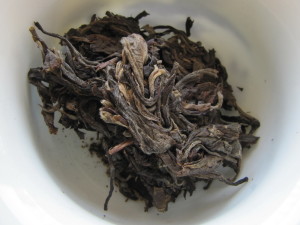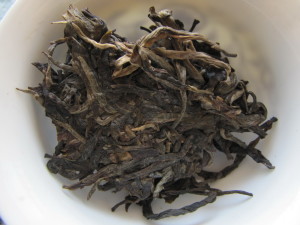A funny thing. A year or so ago, someone was telling me that they had seen something online about storing Puer tea, and how the author had “blown a hole through the whole Puer storage b.s.” He went on to explain that the article stated that sheng was better stored in a sealed bag, and that there would be enough air in the bag for the tea to age well.
If you’ve drunk any, say, year old mao cha that’s been stored in an airtight bag you’ll likely be a shade skeptical of this hypothesis, but not willing to dismiss the idea completely, I had a look at the article in question and then put a cake of last year’s tea in a ziploc bag and forgot about it.
That was just over a year ago, so I decided to open it up and compare the sealed tea with one that has been in the shop. A year’s not long, but there were no real surprises.
There are some assumptions about the airtightness of the bag, which is probably not 100%, and whilst I attempted to remove most of the air from the bag before sealing it, it was a long way from vacuum sealed.
In comparing the teas I was also trying some different water which felt a little too hard to bring out the best in the tea.
The sealed tea is on the left.
The Bag-stored tea
The tea that was in the bag looked and smelled younger, greener than the other cake. It has retained more of its youthful, fresh aromas: more vegetal and floral. The gaiwan lid has a honey and flowers fragrance. The wet leaves look greener. The broth is a mid-yellow and has some kuse that hangs on the tongue and upper palate, which comes out when steeping times are pushed. There is a distinct retro-olfactory floral fragrance that accompanies the huigan. Later steepings produced some camphor aromas.
The tea is quite smooth and coats the mouth nicely and the huigan lasts well. The tea has maintained a lot of its freshness. It’s clear that it has not oxidised as much as the shop stored tea.
The Shop stored tea
The tea that was in the shop was a cake we have been drinking and so has been out of storage for a few weeks. It smells damper, more of leaves, earth and leather, and is a shade darker in appearance. It has lost some of that ‘new tea’ fragrance but, not surprisingly, has yet to develop any discernable chen wei.
The gaiwan lid gives off more of a camphor fragrance, with the younger floral qualities mostly gone. The broth is a shade darker than the bag-stored tea. The flavour is a little fuller and softer, with more obvious base-notes. The kuse is not so obvious. It still has some of the retro-olfactory qualities of the fresh tea, but they are more muted – less ‘yang’.
The most notable difference is that the shop-stored tea, whilst losing some of the fresh tea aromas, has developed some depth and roundness that the bag tea has not.
Of course, a year in Puertime is no time at all and may not adequately indicate what could happen in the future. The tea in the ziploc bag clearly had enough air to oxidise, but whether that would get exhausted in a few years if the bag were not opened is debatable.





